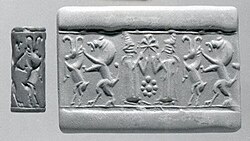
Back Dingir AF دينجير Arabic Dingir AST Dingir AZ Dingir Catalan Dingir Czech Dingir German Dingir Spanish دیگیر FA Dingir Finnish

Dingir ⟨𒀭⟩, usually transliterated DIĜIR,[1] (Sumerian pronunciation: [tiŋiɾ]) is a Sumerian word for 'god' or 'goddess'. Its cuneiform sign is most commonly employed as the determinative for religious names and related concepts, in which case it is not pronounced and is conventionally transliterated as a superscript ⟨d⟩, e.g. dInanna.
The Sumerian cuneiform sign by itself was originally an ideogram for the Sumerian word an ('sky' or 'heaven');[2] its use was then extended to a logogram for the word diĝir ('god' or 'goddess')[3] and the supreme deity of the Sumerian pantheon Anu, and a phonogram for the syllable /an/. Akkadian cuneiform took over all these uses and added to them a logographic reading for the native ilum and from that a syllabic reading of /il/. In Hittite orthography, the syllabic value of the sign was again only an.
The concept of divinity in Sumerian is closely associated with the heavens, as is evident from the fact that the cuneiform sign doubles as the ideogram for 'sky', and that its original shape is the picture of a star. The eight-pointed star was a chief symbol for the goddess Inanna. The original association of 'divinity' is thus with 'bright' or 'shining' hierophanies in the sky.